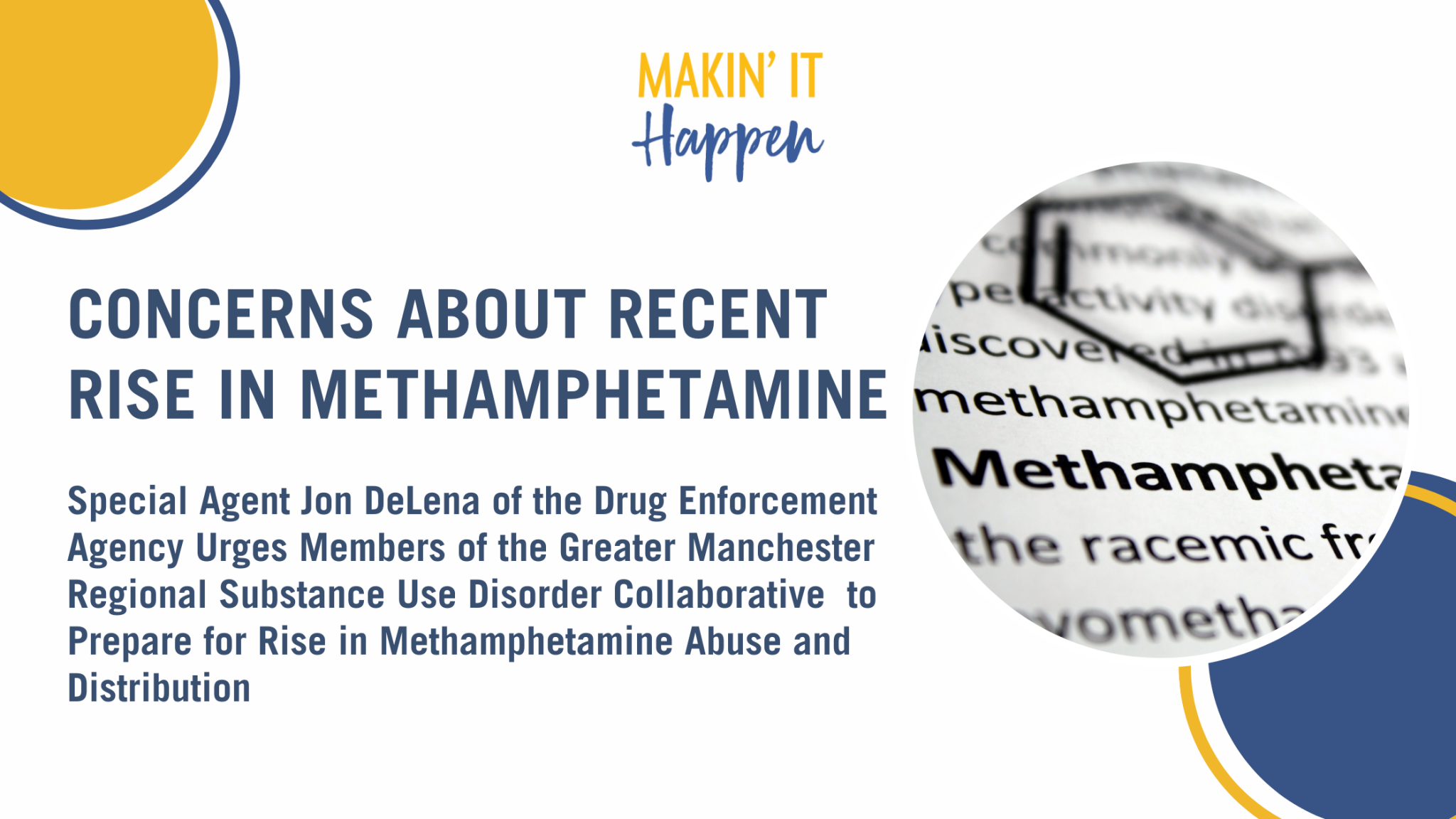 Methamphetamine distribution and abuse is on the rise across New Hampshire and the United States. Jon DeLena, Associate Special Agent in Charge at the Drug Enforcement Administration presented to the Substance Use Disorder Collaborative on January 12th, 2021 regarding this disturbing trend. In speaking of this uptick in methamphetamine use Special Agent DeLena expressed “the fear is that this heroin epidemic will look like the minor leagues compared to this, if crystal methamphetamine explodes the way that we think it is”.
Methamphetamine distribution and abuse is on the rise across New Hampshire and the United States. Jon DeLena, Associate Special Agent in Charge at the Drug Enforcement Administration presented to the Substance Use Disorder Collaborative on January 12th, 2021 regarding this disturbing trend. In speaking of this uptick in methamphetamine use Special Agent DeLena expressed “the fear is that this heroin epidemic will look like the minor leagues compared to this, if crystal methamphetamine explodes the way that we think it is”.
Traditionally we think of methamphetamine or meth as a homemade product created in somebody’s apartment or a trailer, or even out in a park somewhere being made in small amounts. On an average, a homemade methamphetamine lab can produce between five and ten grams, which is a very small amount in a very low purity. This type of methamphetamine can easily be created in someone’s home with ingredients available locally. This new, cartel created type of methamphetamine looks like ice, and that’s actually one of the names for it. Right now, Ice is exploding throughout New England.
Mexican organizations have attempted to create a market for crystal methamphetamine here in the states for many years. Up until now it’s never really caught on in New England, however the perfect storm of events has created a high demand for products which the cartels have available in bulk. A typical homemade lab in New Hampshire can produce five to ten grams in an hour while a Mexican cartel super lab may create upwards of seven tons every three days. Mexican cartels are using their laboratories to create a less expensive product that is high purity in a greater quantity.
Similar to fentanyl, people are snorting and smoking methamphetamine, but sadly, many eventually start to inject it. Methamphetamine is one of the cheapest street drugs available to those living in active addiction. It’s more available here in New Hampshire, and folks do not have to travel down to Massachusetts to find the substance.
The Mexican cartels are producing methamphetamine pills to look like pharmaceutical grade medication. The cartels have the best equipment and top scientists to support what they are doing. They are making the methamphetamine to look like Adderall. Adderall is commonly prescribed stimulant to those experiencing Attention Deficit Hyperactivity Disorder (ADHD). According to American Journal of Psychiatry, nearly 5 million Americans are prescribed stimulants like Adderall to treat their ADHD. Adderall is widely available as a result and is also a commonly abused drug. Known as the ‘study-buddy’ many use Adderall for its side effects and it can be highly addictive to those that do not use it as prescribed. Adderall is a controlled substance making its availability limited. Methamphetamine that masquerades as Adderall is extremely dangerous as many will believe they are taking a regulated prescription drug but they will actually be taking an illegally manufactured and highly potent street drug. The effects of Adderall are extremely different than those produced by methamphetamine.
The Mexican cartels continue to use the same transportation methods and distribution channels that they have utilized in the past to distribute other substances. These distribution channels have been somewhat disrupted by COVID however the fear is that once COVID restrictions are lifted more meth will flow into the country.
Methamphetamine is an incredibly dangerous substance. There’s an extremely high level of violence associated with people that are under the influence of crystal methamphetamine. This violence puts first responders at an increased risk when responding to calls involving methamphetamine. The State of New Hampshire, the DEA, HIDTA and other law enforcement are working diligently to respond to this crisis and keep first responders safe.
Treatment and recovery organizations throughout New Hampshire are seeing a slight increase in patients experiencing a Methamphetamine Use Disorder (MUD). Treatment of MUD has challenges unlike the treatment of other substances. There is no medication to support treatment of methamphetamine use disorder. Methamphetamine use can lead to physical structural changes in the brain. It can take up to a year for the brain to heal from methamphetamine use. Those in treatment and recovery for a MUD need extra care as their brain heals.
Prevention must be a part of this response. Organizations like Makin’ It Happen will continue to work diligently to educate the public and provide resources around methamphetamine.
DEA is initiating a new project in New Hampshire, called OPERATION ENGAGE, which is similar to DEA 360. DEA is making one of the first, sustainable locations around the country for ENGAGE to be New Hampshire, based on the tremendous success and great partnerships built with DEA 360. Special Agent DeLena has confirmed that this dedicated effort will strongly include Prevention efforts focused on the Methamphetamine trend.



